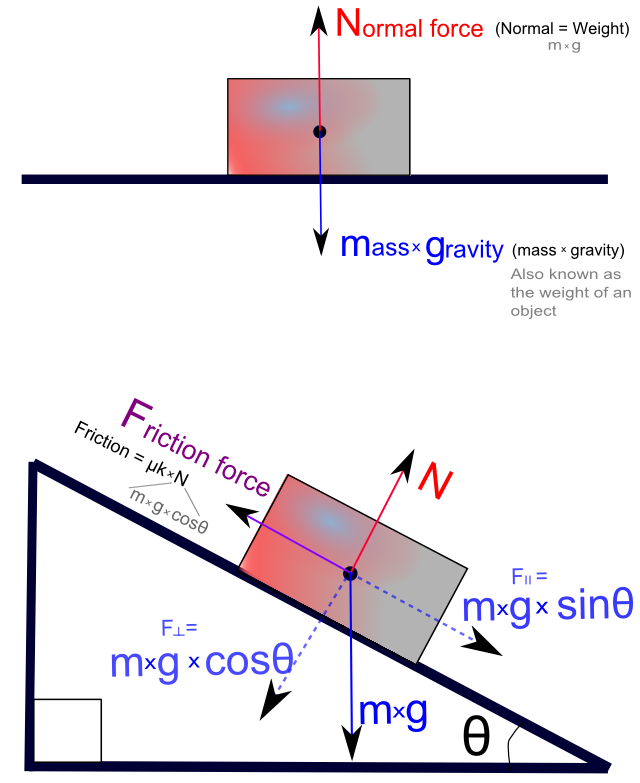A coefficient of friction is a value that shows the relationship between the force of friction between two objects and the normal reaction between the objects that are involved. It is a value that is sometimes used in physics to find an object’s normal force or frictional force when other methods aren’t available.
The coefficient of friction is shown byFƒ = μ Fn In that equation,Fƒ is the frictional force, μ is the coefficient of friction, Fn is the normal force.
The coefficient μ can be two different things. It is either the coefficient of static friction μs or the coefficient of kinetic friction μk. The coefficient of static friction is the friction force between two objects when neither of the objects is moving. The coefficient of kinetic friction is the force between two objects when one object is moving, or if two objects are moving against each other.
The coefficient of friction is dimensionless, meaning it does not have any units. It is a scalar, meaning the direction of the force does not affect the physical quantity.
The coefficient of friction depends on the objects that are causing friction. The value is usually between 0 and 1 but can be greater than 1. A value of 0 means there is no friction at all between the objects. This is only theoretically possible. All objects in the real world will have some friction when they touch each other. A value of 1 means the frictional force is equal to the normal force. Some people think that the coefficient of friction can never be more than 1, but this is not true. A coefficient of friction that is more than one just means that friction is stronger than the normal force. An object such as silicone rubber, for example, can have a coefficient of friction much greater than one. The coefficient of friction can also be changed by the mass and speed of the moving object.
The friction force is the force exerted by a surface when an object moves across it – or makes an effort to move across it.
The frictional force or force of friction can be expressed as
Fƒ = μ N (1)
where
Fƒ is the frictional force (in Newton),
μ is the static (μs) or kinetic (μk ) frictional coefficient (dimensionless) and
N is the normal force (in Newton).
Friction
Friction is a force that acts to stop the movement of two touching things. The energy lost to friction is turned into sound and heat. Two kinds of friction are static and kinetic. Static friction is when the friction is strong enough to stop movement between two objects. Kinetic friction is when the frictional force is not strong enough to stop all motion.
Some facts about friction are:
- Friction can be thought to be caused by bumps on two touching surfaces. These bumps are called asperities. As these two rough surfaces move against each other they get stuck and prevent motion until the asperities are broken or slid over. Even the smoothest materials have these asperities.
- As the force that is pushing on an object increases, the static friction increases too. However, if the force gets bigger than the maximum static friction, it makes the object accelerate (begin to move). The thing will begin to accelerate as soon as the static friction is less than the force pushing on it. After that point kinetic friction will act on the object.
- The coefficient of friction is the ratio between the force slowing something down and the force pushing them together. The larger it is the stronger friction is (and the more the object is slowed down). For example, a person’s skates on ice have a small coefficient of friction, but rubber on concrete has a big one.
- Internal friction in a fluid is called viscosity. Viscosity is how hard it is for the fluid to move or flow. For example, honey is more “viscous” than water.
- Friction is really caused by electromagnetism. When the atoms that make the objects come close they are drawn to each other and may connect. Effort is needed to break this connection in objects that are not moving and effort is needed to keep an object moving against this attraction. Things with high friction have many points of contact or have atoms that strongly attract others.
Coefficient of friction

